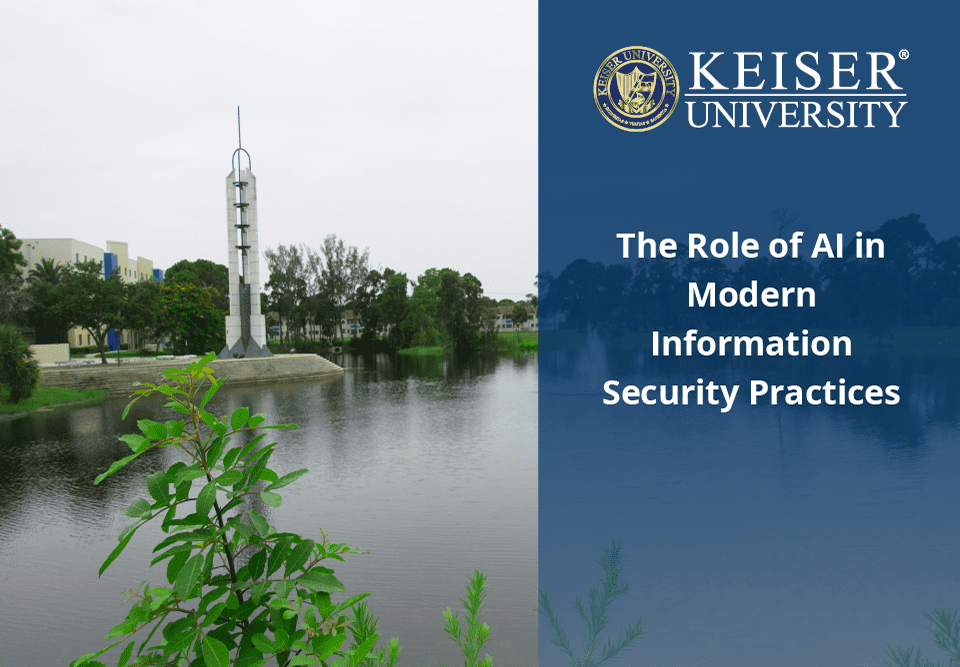Modern cybersecurity practices recognize that artificial intelligence (AI) represents both an opportunity and a risk. On one hand, malicious actors are leveraging AI to design sophisticated cyberattacks, exploit vulnerabilities, and infiltrate secure systems. However, AI in information security (InfoSec) has become an essential organizational strength. By automating defenses, improving threat detection, and reducing response time, AI enables IT professionals to strengthen their organizations’ ability to prevent, identify, and contain breaches. In short, AI is reshaping the role of AI in IT security and proving that it is here to stay.
Introduction to AI in Cybersecurity
While it is revolutionizing industries from healthcare to marketing to truck driving, AI and information security are two closely intertwined disciplines.
What Is Artificial Intelligence?
At its core, Artificial intelligence systems are operated from data centers, which house distributed computing infrastructure that includes hundreds of thousands of processing units. These units can quickly perform billions of calculations across neural networks. The computational power enables AI systems to replicate certain functions of human intelligence — such as learning from experience, understanding language through natural language processing (NLP), and making informed decisions. infrastructure.
Why AI in Information Security Matters
The role of AI in IT industry advancements is particularly visible in cybersecurity. AI’s ability to analyze massive volumes of data, identify anomalies, and predict potential risks gives it tremendous power to prevent cyberattacks and uncover vulnerabilities. By providing real-time monitoring and automated alerts, AI security tools help organizations respond faster, often reducing costly delays linked to human error. In today’s digital landscape, the combination of AI and information security is no longer optional — it is critical to organizational resilience.
Key Applications of AI in Cybersecurity
From detecting unusual user behavior to automatically blocking malicious IP addresses, AI is making the job of InfoSec professionals simultaneously more efficient and more challenging. Some of the most noteworthy applications of this technology in the world, from detecting unusual user behavior to automatically blocking malicious IP addresses, AI is reshaping the responsibilities of information security (InfoSec) professionals. These advancements make modern cybersecurity practices both more efficient and, at times, more complex to manage. Some of the most noteworthy applications that highlight the role of AI in IT security include:
Threat Detection and Prevention
Traditional methods of threat detection were often slow and asynchronous, but AI’s ability to monitor and analyze copious amounts of data offers real-time monitoring of network traffic and system logs. Machine learning helps AI to detect malware and phishing attempts faster and more accurately than ever before.
Automated Incident Response
Faster than traditional methods, AI-driven automated incident response can respond to security breaches by isolating systems, blocking IPs and minimizing damage.
Behavioral Analytics and User Monitoring
The acronym UEBA describes user and entity behavior analytics, which can be powered by AI systems that track and analyze behavior from both users and devices. UEBA can help uncover insider threats and compromised accounts at businesses, government agencies and other organizations.
Benefits of Using AI in Security Practices
According to IBM and other leaders in developing AI solutions for cybersecurity, organizations that integrate AI in their security programs are transforming their ability to prevent and respond to threats. In 2024, IBM reported that the average cost of a data breach was $4.4 million — a 9% decrease over 2023 — driven by faster threat identification and containment made possible by AI.
Increased Efficiency and Speed
IBM’s 2024 report on the impact of AI in IT security showed that businesses that fully deployed AI systems saved an average of $3 million in data breach costs, primarily due to faster, more efficient systems. Overall, organizations that used any type of AI to protect their systems saved $1.9 million in operating costs.
Scalable Solutions for Enterprise Security
Scalable solutions for enterprise security can adapt to growing demands, including increased data, growth in users or complex attacks. Cloud infrastructure can scale analysis of thousands to millions of devices, and artificial intelligence platforms can use machine learning and AI technology to detect and predict threats at scale.
Predictive Capabilities
One of the most valuable strengths of AI in information security is its ability to anticipate threats before they occur. By analyzing vast datasets, AI systems can analyze vast amounts of data to predict potential weaknesses and rank the likelihood of attacks. Several AI-driven platforms use real-time data to create defenses before an attack occurs. Other AI-driven services can identify threats through behavioral analysis. Additional technologies include natural language processing (NLP), which can help predict and block phishing emails or identify fake websites. These predictive functions demonstrate the evolving role of AI in IT security and its importance in modern cybersecurity practices.
Forecasting Future Vulnerabilities
Just as past performance helps predict future behavior in people, it also guides the role of AI in IT security. By analyzing historical incident data, AI systems can anticipate potential weaknesses and highlight areas most likely to be targeted in future attacks. Techniques such as system and software profiling, combined with machine learning models trained on global threat data, enable AI to spot patterns across networks, applications, and even the dark web. This predictive capability helps InfoSec teams address vulnerabilities proactively, reducing reliance on reactive measures and strengthening the connection between AI and information security.
AI Adoption Challenges and Risks
Although IBM reports that organizations with “the most mature security AI and automation capabilities have a 40% higher return on security investment” than others, there are still risks and challenges in adopting AI information security technology.
Bias in AI Algorithms
The effectiveness of AI in information security depends heavily on the quality of the data used to train its machine learning models. When that data is incomplete or biased, the system may misidentify threats, generate inaccurate alerts, or fail to detect real vulnerabilities. This creates a critical risk where the role of AI in IT security could inadvertently reinforce blind spots rather than strengthen defenses. To counter these issues, cybersecurity teams must prioritize diverse training data, continuous retraining of neural networks, and human oversight to ensure AI security tools remain accurate and unbiased.
High Implementation Costs
Implementing AI in information security can be expensive. The costs often include purchasing or leasing advanced infrastructure such as data centers, maintaining cloud services, and providing continuous updates to machine learning models. For smaller businesses, these expenses can make AI adoption seem out of reach. Even organizations that can afford the initial investment may be tempted to delay or skip updates, which can lead to outdated systems with ineffective threat detection. To maximize the role of AI in IT security, businesses must view ongoing training, monitoring, and upgrades as essential parts of modern cybersecurity practices.
Dependency Risks and False Positives
Relying too heavily on AI in information security introduces its own risks. Outdated or poorly trained systems may generate positive, overwhelming IT teams with unnecessary alerts and divert attention from genuine threats. At the same time, these systems can still miss sophisticated attacks, leaving organizations exposed. When the role of AI in IT security is mismanaged, the consequences may include data breaches, financial losses, regulatory penalties, and reputational damage. To minimize these risks, InfoSec teams must pair AI security tools with human oversight, ensuring that automated defenses complement — rather than replace — professional judgment.
AI in Cybersecurity Use Cases
Major players in cybersecurity AI, including IBM and Ernst & Young, provide extensive documentation and examples of the role of AI in IT security.
Financial Sector Cybersecurity Tools
According to IBM’s Institute for Business Value, in 2024, 61% of financial executives surveyed said that fraud risk detection was the biggest AI benefit to their businesses. Additionally, more than half of the executives said that AI would also provide basic cybersecurity benefits to their financial institution. AI tools for the financial sector include tools to know your customer (KYC) and provide anti-money laundering (AML). Agentic (or autonomous) AI can orchestrate sub-agents that can learn customer behavior in real time as well as flag potential risks for human review and intervention.
Healthcare Data Protection
In a healthcare environment with rising costs and the need to maintain confidential patient information, AI security tools can help reduce bureaucracy and back-office tasks like budgeting, billing, and record-keeping. In 2024, more than half of healthcare executives surveyed by IBM’s Institute for Business Value said that data protection for patients and cybersecurity in general were their greatest challenges, and AI systems to aid in the process are still in development.
AI-Powered SOCs (Service and Organization Controls)
Cybersecurity frameworks, including International Organization for Standardization (ISO) 27001, set and maintain the standards for information security. The System and Organization Controls 2 (SOC 2) framework developed by the American Institute of Certified Public Accountants (AICPA) provides regulatory standards for data security and protection and for disclosing breaches and performance to the Securities and Exchange Commission (SEC). Agentic AI can help businesses meet these standards meant to protect businesses, investors and customers.
AI in Government Cybersecurity
According to the National Security Agency (NSA), the Artificial Intelligence Security Center (AISC) is the primary U.S. government organization that is implementing and overseeing the national efforts to adopt AI to protect the nation from threats and advance partnerships with industry experts. NSA refers to AI as “a rapidly growing and changing technology, providing incredible opportunities and challenges.”
AI in Cybercrime
According to CrowdStrike, AI is increasingly used in cyberattacks that:
- Identify vulnerable computer systems.
- Design and advance attack plans.
- Exfiltrate or infiltrate systems to damage businesses, hold systems for ransom or steal critical data.
Cybercriminals can and do deploy their own AI systems to conduct automated attacks, gather data and reinforce learning to overcome cybersecurity defenses. Cyberattacks using AI are one of the most crucial reasons information security professionals need to understand the role of AI in the IT industry.
Future Trends in AI for Information Security
Zero-Day Exploits
Zero-day exploits — when cybercriminals attack an organization’s systems using unknown flaws in their cybersecurity — are an IT professional’s nightmare. Artificial intelligence is expected to play an ever-greater role in both preventing, and potentially causing, zero-day exploits in the future.
Integration With Blockchain and IoT Security
Existing technologies like blockchain and Internet of Things (IoT) devices require protection, which AI can deliver. AI may automate security for IoT systems as well as provide transparency in blockchain use and transactions.
Advancements in Federated Learning and Privacy AI
Local devices vs. cloud storage are the idea at the heart of advancements in federated learning as a privacy solution. These approaches to cybersecurity enable local devices to train on sensitive data, then send encrypted updates to centralized servers, thereby maintaining data security and reducing the risk of data breaches.
AI for Cyber Threat Intelligence (CTI)
Cyber threat intelligence, aka CTI, can use automated AI to scrape the dark web and other sources to identify threats. AI can process millions of data points quickly and use pattern recognition and machine learning to detect patterns of attack for ransomware and other sophisticated threats.
FAQs: Embracing AI for a Safer Digital Future
In short, artificial intelligence is aiding cybercriminals at the same time as it is helping organizations protect against them and mitigate the negative effects of their attacks. Here are more straightforward answers to a couple of key questions:
What is the role of AI in cybersecurity?
The role of AI in IT security is to complement and enhance modern cybersecurity practices. AI security tools can analyze vast amounts of data, recognize patterns, detect threats, and respond in real time — often faster and more accurately than traditional systems. By reducing human error and improving threat detection, AI and information security now work hand in hand to safeguard organizations in an increasingly complex digital landscape.
Can AI completely replace human cybersecurity professionals?
Human cybersecurity professionals offer the strategic decision-making, judgment, and planning capacity that AI cannot — so AI is unlikely ever to replace human cybersecurity professionals. AI also cannot ensure legal compliance, nor can it leverage creativity to foresee and mitigate unknown and emerging threats.
What are the top AI tools used in information security today?
Some of the most widely used AI tools and platforms in information security showcase how artificial intelligence is enhancing traditional cybersecurity by improving speed, accuracy and scalability in threat detection and response. Examples include:
- Darktrace – Applies machine learning and neural networks to detect anomalous behavior on enterprise networks.
- Cylance (by BlackBerry) – Uses AI-driven prevention models to block malware before it executes.
- CrowdStrike Falcon – A cloud-native platform leveraging AI for endpoint detection and response (EDR).
- IBM QRadar with Watson – Combines natural language processing (NLP) with AI for faster threat hunting and incident analysis.
- Vectra AI – Specializes in uncovering hidden threats in cloud, data center, and IoT environments.
These platforms reflect how machine learning, NLP, and neural networks are central to modern cybersecurity practices.
Discover More About the Role of AI in IT Industry Advancements
At Keiser University, we offer graduate programs related to artificial intelligence and cybersecurity, including the:
- Homeland Security and Emergency Management, MA
- Technology Management, MBA
- Information Security, MS
- Information Technology Leadership, MS
Contact us today to learn more about online, in-person and hybrid graduate programs.
Sources
https://www.britannica.com/technology/artificial-intelligence
https://www.ey.com/en_us/insights/cybersecurity/enhancing-cybersecurity-metrics-ciso-strategies
https://www.ibm.com/thought-leadership/institute-business-value/en-us/report/banking-in-ai-era
https://www.ibm.com/reports/data-breach
https://www.ibm.com/thought-leadership/institute-business-value/en-us/report/healthcare-in-ai-era
https://www.ibm.com/thought-leadership/institute-business-value/report/ai-security-automation
https://www.crowdstrike.com/en-us/cybersecurity-101/cyberattacks/ai-powered-cyberattacks/
https://www.ibm.com/think/topics/zero-day
https://www.sciencedirect.com/science/article/pii/S2542660524002592
https://www.sciencedirect.com/science/article/pii/S1877050922023055
https://www.crowdstrike.com/en-us/cybersecurity-101/threat-intelligence/






 The instructors at Keiser University impacted my life. They believed in my ability to become a great graphic designer, regardless of how I felt about my skills. KU helped to prepare me for the real world and got me to where I am today.
The instructors at Keiser University impacted my life. They believed in my ability to become a great graphic designer, regardless of how I felt about my skills. KU helped to prepare me for the real world and got me to where I am today.
